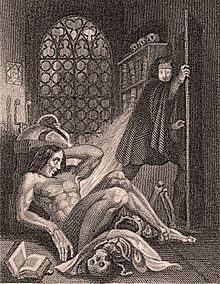Frankenstein's monster
| Frankenstein's monster | |
|---|---|

Steel engraving (993 × 71 mm), for the frontispiece of the 1831 revised edition of Mary Shelley's Frankenstein, published by Colburn and Bentley, London.
|
|
| Created by | Mary Shelley |
| Information | |
| Nickname(s) | "Frankenstein", "The Monster", "The Creature", "The Wretch", "Adam Frankenstein" and others |
| Gender | Male |
Frankenstein's monster, sometimes known as Frankenstein, is a fictional character whose fictional creator was Victor Frankenstein. The monster first appeared, without any name, in Mary Shelley's 1818 novel Frankenstein; or, The Modern Prometheus. Shelley's title thus compares Victor Frankenstein to the mythological character Prometheus who fashioned humans out of clay and gave them fire. Although nameless in Shelley's novel, the creature took on the name "Frankenstein" in later years.
In Shelley's Gothic story, Victor Frankenstein builds the creature in his laboratory through an ambiguous method consisting of chemistry and alchemy. Shelley describes the monster as 8-foot-tall (2.4 m), hideously ugly, but sensitive and emotional. The monster attempts to fit into human society, but is shunned, which leads him to seek revenge against his creator. According to the scholar Joseph Carroll, the monster occupies "a border territory between the characteristics that typically define protagonists and antagonists".
Mary Shelley's original novel never ascribes an actual name to the monster; although when speaking to his creator, Victor Frankenstein, the monster does call himself the "Adam of your labours" (in reference to the first man created in the Bible). Victor refers to the monster as "creature", "fiend", "spectre", "the demon", "wretch", "devil", "thing", "being", and "ogre".
It has become common vernacular to refer to the creature by the name "Frankenstein", though this never actually happens in the book. In addition to this, calling the monster "Frankenstein" sometimes results in confusion with his creator, Victor Frankenstein.
As in Mary Shelley's story, the monster's namelessness became a central part of the stage adaptations in London and Paris during the decades after the novel's first appearance. In 1823, Shelley herself attended a performance of Presumption, the first successful stage adaptation of her novel. "The play bill amused me extremely, for in the list of dramatis personae came _________, by Mr T. Cooke," she wrote to her friend Leigh Hunt. "This nameless mode of naming the unnameable is rather good."
...
Wikipedia
